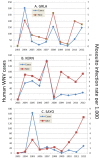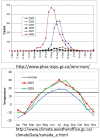Ecology of West Nile virus in North America
- PMID: 24008376
- PMCID: PMC3798891
- DOI: 10.3390/v5092079
Ecology of West Nile virus in North America
Abstract
The introduction, dispersal and establishment of West Nile virus in North America were reviewed, focusing on factors that may have enhanced receptivity and enabled the invasion process. The overwintering persistence of this tropical virus within temperate latitudes was unexpected, but was key in the transition from invasion to endemic establishment. The cascade of temporal events allowing sporadic amplification to outbreak levels was discussed within a future perspective.
Figures






Similar articles
-
West Nile virus: North American experience.Integr Zool. 2011 Sep;6(3):279-89. doi: 10.1111/j.1749-4877.2011.00251.x. Integr Zool. 2011. PMID: 21910847 Review.
-
Declining growth rate of West Nile virus in North America.J Virol. 2007 Mar;81(5):2531-4. doi: 10.1128/JVI.02169-06. Epub 2006 Dec 20. J Virol. 2007. PMID: 17182695 Free PMC article.
-
[West Nile fever/encephalitis as one of the arboviral infections].Uirusu. 2005 Jun;55(1):63-8. doi: 10.2222/jsv.55.63. Uirusu. 2005. PMID: 16308531 Japanese.
-
Outbreak of West Nile virus in North America.Science. 2004 Nov 26;306(5701):1473-5; author reply 1473-5. doi: 10.1126/science.306.5701.1473c. Science. 2004. PMID: 15567836 No abstract available.
-
West Nile virus infection.CMAJ. 2013 Dec 10;185(18):E846. doi: 10.1503/cmaj.130624. Epub 2013 Jul 29. CMAJ. 2013. PMID: 23897943 Free PMC article. Review. No abstract available.
Cited by
-
Emerging infectious diseases and biological invasions: a call for a One Health collaboration in science and management.R Soc Open Sci. 2019 Mar 13;6(3):181577. doi: 10.1098/rsos.181577. eCollection 2019 Mar. R Soc Open Sci. 2019. PMID: 31032015 Free PMC article.
-
Green cities and vector-borne diseases: emerging concerns and opportunities.Euro Surveill. 2024 Mar;29(10):2300548. doi: 10.2807/1560-7917.ES.2024.29.10.2300548. Euro Surveill. 2024. PMID: 38456216 Free PMC article.
-
The Role of Temperature in Transmission of Zoonotic Arboviruses.Viruses. 2019 Nov 1;11(11):1013. doi: 10.3390/v11111013. Viruses. 2019. PMID: 31683823 Free PMC article. Review.
-
Integrated Forecasts Based on Public Health Surveillance and Meteorological Data Predict West Nile Virus in a High-Risk Region of North America.Environ Health Perspect. 2022 Aug;130(8):87006. doi: 10.1289/EHP10287. Epub 2022 Aug 16. Environ Health Perspect. 2022. PMID: 35972761 Free PMC article.
-
Epidemic versus endemic West Nile virus dead bird surveillance in California: Changes in sensitivity and focus.PLoS One. 2023 Apr 6;18(4):e0284039. doi: 10.1371/journal.pone.0284039. eCollection 2023. PLoS One. 2023. PMID: 37023091 Free PMC article.
References
-
- Smithburn K.C., Hughes T.P., Burke A.W., Paul J.H. A neutrophic virus isolated from the blood of a native of Uganda. Am. J. Trop Med. Hyg. 1940;20:471–492.
-
- Campbell G.L., Marfin A.A., Lanciotti R.S., Gubler D.J. West Nile virus. Lancet Infect. Dis. 2002;2:519–529. - PubMed
Publication types
MeSH terms
LinkOut - more resources
Full Text Sources
Other Literature Sources
Medical

